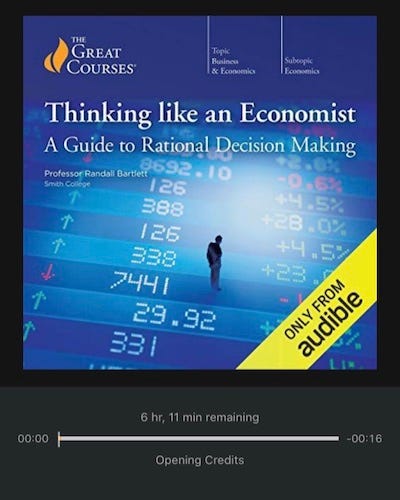Thinking Like an Economist: A Guide to Rational Thinking by Randall Bartlett
2020, book #28: “In a world of scarcity, there is no free lunch, there is always going to be an opportunity cost to be paid.” — Randall Bartlett

Finished on May 1, 2020
This subject matter is always particularly interesting to me. Data is enjoyable and I love looking at the facts and figures. When we talk about economics, there are often widespread impacts throughout multiple levels of society that most people cannot understand or identify. I thought that it would be valuable to gain a better understanding of the rationality behind many of the ways that the world is structured and set up as it presently exists.
Incentives drive everything. It’s interesting to see how people are driven by different things. As for the second item here, people think that they can obtain things for no cost — there is always a cost, even if it’s not tangible. Oftentimes, we cannot see the ripples or the outcomes that be undesired — yet they happen. We are not able to control every aspect of anything; there are always uncontrollable parts of the situations that we are within.
6 foundational premises that all economists accept about humans and their interactions:
1. People respond to incentives.
2. In a world of scarcity, there is no free lunch, there is always going to be an opportunity cost to be paid.
3. You can never do just one thing, every interaction has at least two sides.
4. Everything is interconnected and there can be unanticipated influences.
5. Actions are going to have unintended consequences.
6. No one is ever truly in control.
It all comes down to what matters most. If we are going to the beach and there is a hurricane en route, it’s going to be essential that we identify the goal to get to the beach, the path and timing of the hurricane, and the possible costs or impacts from the route that we elect. Actions have consequences but inaction even greater ones.
Making rational decisions in principle:
1. Clarify the objective or goal.
2. Identify all possible alternative paths to help you get there.
3. Evaluate carefully the payoffs from each of those alternatives.
4. Select the best option and implement that decision.
We may make decisions and then choose the path of least resistance the next time that the time comes up to make a decision so that there is really no “decision” to be made. Yet, that is one reason why millions of people are stuck in the same roles for 20 or 30 or 40 years — status quo bias.
Status quo bias — once we make a decision we usually do not revisit it. Internet companies and magazines know this — that’s one reason they offer a special for the first 12 months and then increase the price.
I learned a lot from this book, honestly much more than I took the time to write down here. There were numerous points of affirmation and confirmation towards the way that I make decisions and actively seek out alternatives or best paths. Many times, we can get caught up in emotion but it is vain to make decisions with lasting consequences solely from the influence of temporary emotions.
I gave this book a 4/5
Join my weekly newsletter to see all of my writing here.